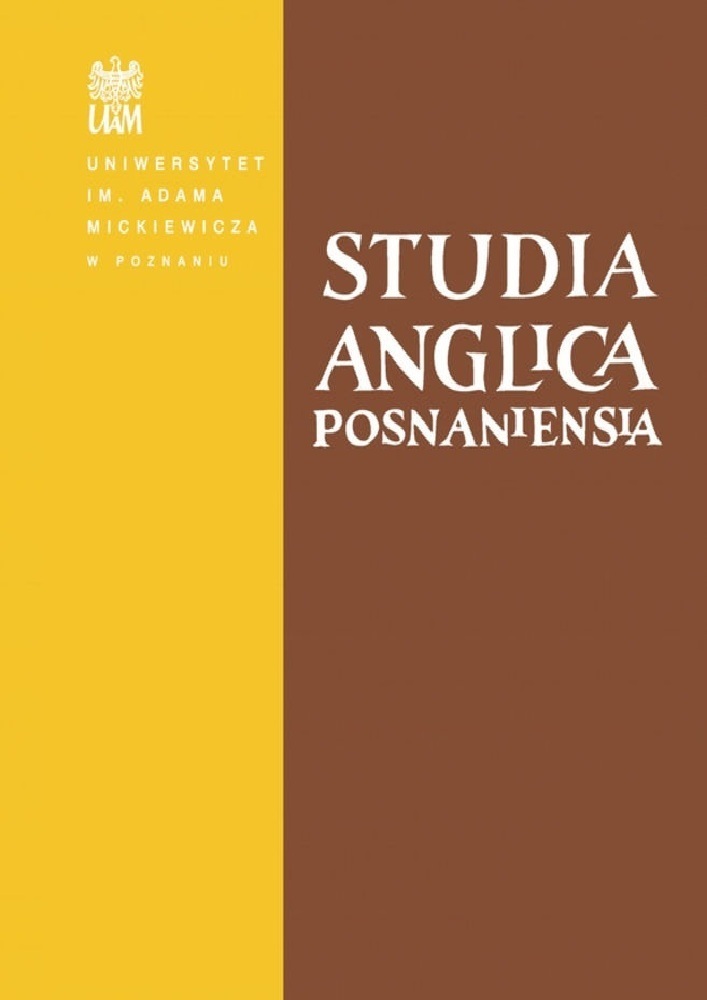Abstract
The aim of my inquiry is to discuss Adam Dickinson’s revisionist approach to the lyric autobiography as shown in his most recent volume Anatomic (2018a). Informed by an eco-critical sensibility, the biotechnological gaze, and post-humanist notions of subjectivity, this highly experimental conceptual project reveals porous boundaries of the autobiographical self caught up in the entanglement of the mind and matter. Based on burden tests of the poet’s own bodily fluids, Anatomic offers a philosophical speculation on the nature of the human, asking us to go beyond anthropocentric positioning of the subject and to consider ethical alongside onto-epistemological implications of this new direction. The methodology employed in my analyses of Dickinson’s poems derives from the influential notions of agential realism, diffractive vision, and intra-action formulated by Karan Barad – a trained quantum physicist and feminist philosopher working in the field of science and technology. Barad’s theories fuel New Materialist paradigms of thought as they propose the inherent indeterminacy of matter as well as question the established views of identity and the social. The particular focus of my interrogations will be the relationship between diffractive perception and the medical gaze used by the Canadian conceptualist to see himself non-anthropologically and thus to destabilize the perimeters of the autobiographical self.
References
Alaimo, Stacy. 2010. Bodily natures: Science, environment, and the material self. Indiana University Press.
Annoni, Marco, Giuseppe Schiavone, Luca Chiapperino & Giovanni Boniolo. 2012. Constructing the Medical Humanities gaze. Critical Reviews in Oncology/Hematology 84(s2). 5–10. DOI: 10.1016/s1040-8428(13)70003-9
Barad, Karen, 2003. Posthumanist performativity: Toward an understanding of how matter comes to matter. Signs: Journal of Women in Culture and Society 28(3). 801–831. DOI: 10.1086/345321
Barad, Karen. 2007. Meeting the universe halfway: Quantum physics and the entanglement of matter and meaning. Duke University Press.
Barad, Karen. 2010. Quantum entanglements and hauntological relations of inheritance: Dis/continuities, spacetime enfoldings, and justice-to-come. Derrida Today 3(2). 240–268. DOI: 10.3366/drt.2010.0206
Barad, Karen. 2012a. On touching – The inhuman that therefore I am. Differences: A Journal of Feminist Studies 23(3). 206–223. DOI: 10.1215/10407391-1892943
Barad, Karen. 2012b. Nature’s queer performativity. Kvinder, Køn & Forskning 1–2. 25–54. DOI: 10.7146/kkf.v0i1-2.28067
Bök, Christian. 2003. Crystallography (2nd edn). Coach House Press.
Bök, Christian. 2015. The xenotext. Coach House Press.
Braidotti, Rosi. 2013. The posthuman. Polity Press.
Calvert-Minor, Chris. 2014. Epistemological misgivings of Karen Barad’s ‘posthumanism’. Human Studies 37(1). 123–137. 10.1007/s10746-013-9285-x
Campbell, Norah. 2007. The technological gaze in advertising. Irish Marketing Review 19(1–2). 3–18. DOI: 10.21427/D72B6J
Dickinson, Adam. 2013. Better living through ‘pataphysics’: The biosemiotics of Kenneth Goldsmith. In Mark J. Smith (ed.), Time in time: Short poems, long poems, and the rhetoric of North American avant-gardism, 1963–2008, McGill-Queen’s University Press. 132–151.
Dickinson, Adam. 2014. Pataphysics and postmodern eco-criticism: A prospectus. In Greg Garrard (ed.), The Oxford handbook of eco-criticism, Oxford University Press. 132–153. DOI: 10.1093/oxfordhb/9780199742929.013.011
Dickinson, Adam. 2018a. Anatomic. Coach House Books.
Dickinson, Adam. 2018b. “The human endocrine system represents a kind of poetics”: Adam Dickinson on his poetic, chemical autobiography. Lucky Seven Interview. Open Book 24/05/2018. https://open-book.ca/News/The-Human-Endocrine-System-Represents-a-Kind-of-Poetics-Adam-Dickinson-on-his-Poetic-Chemical-Autobiography (accessed 02/09/2019).
Dickinson, Adam. 2018c. The body as bacteria: A conversation with Amatoritsero Ede. Maple Tree Literary Supplement 23. https://www.mtls.ca/round-table/ (accessed 06/07/2019).
Dickinson, Adam. 2019. ‘Prickly new cells’: Diffractive reading and writing in Juliana Spahr’s The Transformation. Jacket2 17/07/2019. https://jacket2.org/commentary/prickly-new-cells (accessed 15/02/2020).
Dijck, José van. 2005. The transparent body: A cultural analysis of medical imaging. University of Washington Press.
Haraway, Donna J. 1991. Situated knowledges: The science question in feminism and the privilege of partial perspectives. In Donna Haraway (ed.), Simians, cyborgs, and women: The reinvention of nature, Routledge. 183–201,
Haraway, Donna J. 1997. ModestˍWitness@SecondˍMillennium. FemaleMan©ˍMeetsˍOncoMouse™: Feminism and technoscience. Routledge.
Herzogenrath, Bernd. 2009. Nature/geophilosophy/machinics/ecosophy. In Bernd Herzogenrath (ed.), Deleuze/Guattari & ecology, Palgrave-MacMillan. 145–165.
Hoffmann, Roald & Iain Boyd Whyte (eds). 2011. Beyond the finite. The sublime in art and science. Oxford University Press.
Hoffmeyer, Jesper. 1996. Signs of meaning in the universe (translated by Barbara J. Haveland). Indiana University Press.
Keller, Lynn. 2017. Recomposing ecopoetics: North American poetry of the self-conscious Anthropocene. Virginia University Press.
Krauss, Rosalind E. 1986 [1978]. Grids. In Rosalind E. Krauss, The originality of the avant-garde and other modernist myths, MIT Press. 9–22.
Ladkin, Sam. 2007. Problems for lyric poetry. In Robin Purves & Sam Ladkin (eds.), Complicities: British poetry 1945–2007, Litteraria Pragensis. 271–322.
Leon, Sam. 2018. Review of Anatomic. Colorado Review 18/10/2018. https://coloradoreview.colostate.edu/reviews/anatomic/ (accessed 05/08/2019)
Levinas, Emmanuel. 1981. Otherwise than being, or beyond essence (translated by Alphonso Lingis). Martinus Nijhoff.
Man, Paul de. 1984. The rhetoric of Romanticism. Columbia University Press.
Mulvey, Laura. 1992 [1975]. Visual pleasure and narrative cinema. In Leo Braudy & Marshall Cohen (eds), Film theory and criticism, Oxford University Press. 746–757.
Nicholls, Peter. 2013. Modernism and the limits of lyric. In Marion Thain (ed.), The lyric poem: Formations and transformations, Cambridge University Press. 177–194. DOI: 10.1017/CBO9780511863202.010
Rugg, Linda Haverty. 1997. Picturing ourselves: Photography and autobiography. Chicago University Press.
Scigaj, Leonard M. 1996. Contemporary ecological and environmental poetry: Différance or référance? Interdisciplinary Studies in Literature and Environment 3(2). 1–25. DOI: 10.1093/isle/3.2.1
Slovic, Scott. 2019. Too small, too slow: Making toxicity poignant through poetry. The Arithmetic of Compassion 06/06/2019. https://www.arithmeticofcompassion.org/blog/2019/6/5/too-small-too-slow-making-toxicity-poignant-through-poetry (accessed 04/07/2019)
Smith, Mark. J. 2013. Introduction. In Mark J. Smith (ed.), Time in time: Short poems, long poems, and the rhetoric of North American avant-gardism, 1963–2008, McGill-Queen’s University Press. 3–22.
Smith, Sidonie & Julia Watson. 2002. Reading autobiography: A guide for interpreting life narrative. University of Minnesota Press.
Thiele, Kathrin. 2018. Ethos of diffraction: New paradigms for a (post)humanist ethics. In Brigit M. Kaiser & Kathrin Thiele (eds.), Diffracted worlds – diffractive reading: Onto-epistemologies and the critical humanities, Routledge. 202–216.
Voyce, Stephen. 2007. The xenotext experiment: An interview with Christian Bök. Postmodern Culture 17(2). http://pmc.iath.virginia.edu/issue.107/17.2voyce.html (accessed 17/08/2019)
Whitman, Walt. 2007 [1881]. Song of myself. In Reesman Jeanne Campbell & Arnold Krupat (eds.), Norton anthology of American literature. Vol. C: 1865–1914 (7th edn), WW Norton & Company. 30–74.
